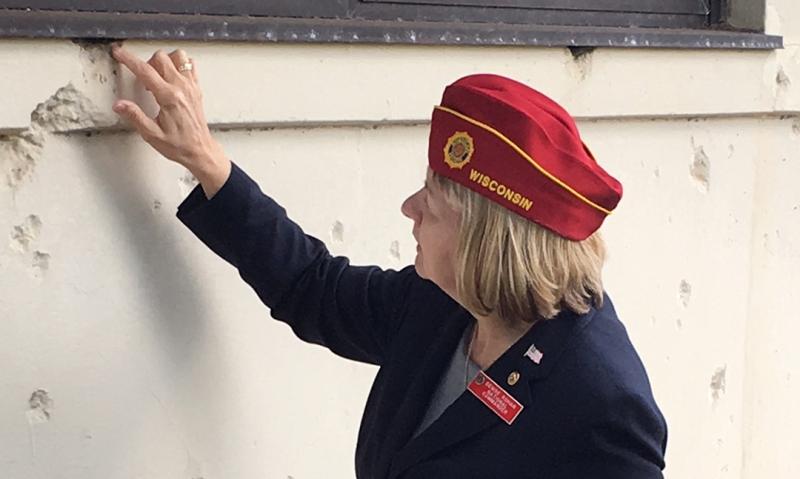
National commander reflects on day of infamy
The attack lasted less than two hours but the scars remain 76 years after the day that changed the world. American Legion National Commander Denise H. Rohan placed her hands in the bullet holes and shrapnel marks left by Japanese pilots upon the old Hickam barracks, which has since been converted into the headquarters for Joint Base Pearl Harbor-Hickam.
“Seeing and feeling those holes brought home the fact that this isn’t just a part of ancient history but a massive and surprise attack that was witnessed by survivors that are still with us today,” Rohan said. “We owe it to them to ensure that America remains strong and vigilant so that we will not have to fight another world war to keep the freedom that they so bravely defended.”
Rohan placed a wreath on the USS Arizona Memorial, a monument built directly above the ship’s wreckage. “Even today, you can see the oil seeping from the USS Arizona,” Rohan said. “It’s often called the tears of the Arizona. When you think of the families who lost loved ones and the crew who watched their comrades die, you can understand the sadness. But with the sadness came hope and resolve like the world had never seen before.”
One person who never lost hope after Pearl Harbor was British Prime Minister Winston Churchill, according to Pulitzer Prize winning author Steve Twomey.
“For the first time in two years of war, (Churchill) felt England would live. Pearl Harbor had given him a partner, a full reliable game-changing partner,” Twomey said during his keynote address at the National Pearl Harbor Remembrance Day Commemoration in Hawaii.
The isolationist sentiment in the United States vanished immediately after the attack.
“At the time, people were anti-war. They were pacificists,” said Charles Van Valkenburgh, a California Legionnaire who attended the commemoration. “If not for an event like Pearl Harbor, I don’t know that we would have joined the war against the Axis Powers. Even today it gets me emotional.”
Van Valkenburgh’s emotions are understandable. His grandfather, Franklin Van Valkenburgh, was the captain of the USS Arizona and earned the Medal of Honor posthumously for defending his ship until the very end.
“Stay vigilant because it only takes moments for an aggressor to change the world and it’s our responsibility to ensure it never happens again,” the younger Van Valkenburg said.
In a tribute to the fallen and the few remaining Pearl Harbor survivors that were in attendance, Adm. Scott H. Swift stressed the determination and bravery that abounded among the military during the attack.
“Within the chaos that morning there was no shortage of bravery, as sailors, soldiers, airmen, Marines and Coast Guardsmen overcame shock, uncertainty and fear in the heat of battle to find something greater within themselves: a grim determination to survive and an unwavering resolve to fight,” Swift said at the commemoration. “Unsurprisingly, in my experience, none of these heroes considers themselves as such: they all say they were just doing their job.”
Rohan, who was joined by American Legion Auxiliary National President Diane Duscheck, Auxiliary National Executive Director Mary “Dubbie” Buckler, Sons of The American Legion National Commander Danny Smith and Legionnaires from the Department of Hawaii, also visited the USS Oklahoma Memorial, the USS Utah Memorial and the National Cemetery of the Pacific during her visit to the Aloha state.
